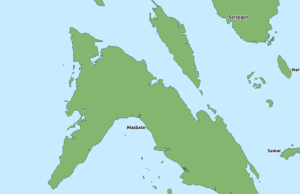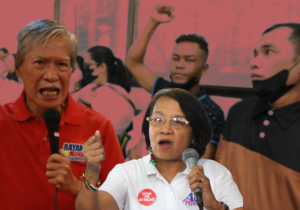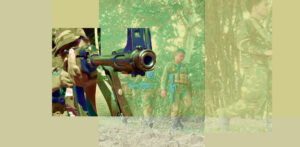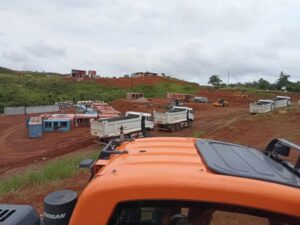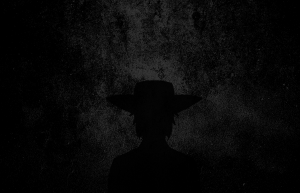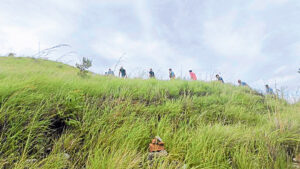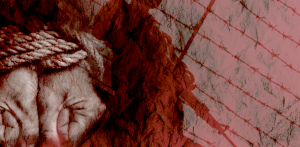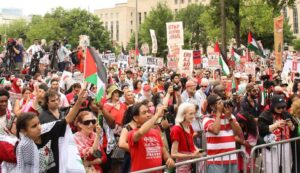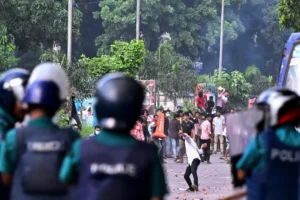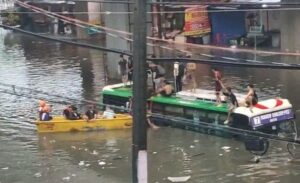Ang Bayan interview with FFPS-Vancounver

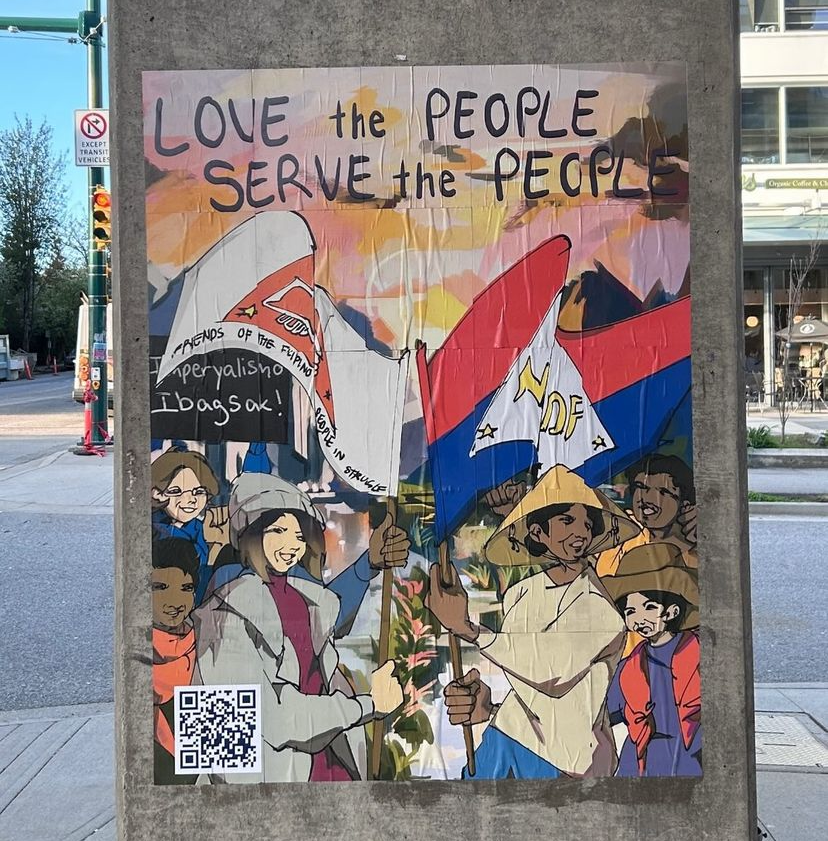
On April 24, an image of an artwork depicting the Filipino’s people’s revolutionary struggle and international solidarity pasted on major public places in Vancouver, Canada made the rounds of social media. The mural was made by artists and activists affiliated with the Friends of the Filipino Peoples in Struggle.
Ang Bayan interviewed the FFPS chapter in Vancouver, Canada about the mural and its activities in line with the commemoration of the 51st anniversary of the National Democratic Front of the Philippines (NDFP) last April 24. The FFPS is a global solidarity organization supporting the national-democratic movement in the Philippines. It has member organizations from North America, Europe, Asia and Oceania.
Ang Bayan (AB): Where was the mural put up?
FFPS-Vancouver: We put up the mural and posters of the artwork at high traffic train stations in Vancouver, Canada. Vancouver is a major port city in the province of British Columbia, Canada, with major industries focused on mining/resource extraction, import/export, real estate, and retail. Thousands of working people pass through these train stations everyday during their commutes and these people are struggling with the cost of living as the capitalist class grows richer and richer. While putting up posters, we spoke to one healthcare worker who was moved by the slogan “Love the People, Serve the People” and shared that she hopes for a revolutionary movement like the one in the Philippines in her homeland of Ethiopia.
AB: How was the mural created? What were the preparations?
FFPS-Vancouver: Our organization wanted to celebrate the NDFP and one of the members of the Propaganda Committee was really into the idea of creating art that would illustrate the significance of the occasion and draw a lot of attention. We asked the members of our organizations if anyone wanted to participate in this art and a new member volunteered.
A few of our members met to discuss what it could look like, and we used a few popular paintings depicting the NDFP as a reference for how to represent the alliance between multiple sectors. One of the members had the idea to show the alliance between the revolutionary mass movement in the Philippines and those of us in Vancouver who are in solidarity with the Filipino People’s struggle to demonstrate the importance of international solidarity. We came up with the idea of depicting the masses on their respective lands carrying the flags of their organization.
It was a back and forth process between the artist and our propaganda officer with input from other members of the org on what it should look like. A concept was created compiling reference images of backgrounds and people demonstrating for the artist to create the art. Once the digital art was completed, we printed it across 25 sheets of letter sized paper. Three of our members used wheatpaste to apply the mural to a concrete pillar at the train station.
AB: What can the artists say about the artwork?
FFPS-Vancouver: After the initial concept was created, the primary artist began with painting the background. The mountains of both regions are looming in the backdrop, representing the connection between the people and the land they live and work on. This was to show that the people’s struggles for land and livelihood are connected around the world because we share a common enemy in imperialism and a common desire for a liberatory society that works for the people.
She wanted to use saturated colors to make the art stand out and evoke the vibrancy of the movement. There was both the practical function of attracting people’s attention to the art and the symbolic nature of red and yellow representing people’s resistance to exploitation. She wanted to use the brightness of the sun and vibrancy of the sunrise to arouse people’s spirits and inspire hope for liberation.
Regarding the background, on the side of the Philippines, there are many rich green hues used to illustrate the agrarian character. Whereas on the Vancouver side, there are more gray hues to illustrate the industrial nature of Canada.
The artist looked at references of peasants in the Philippines to represent the masses in the Philippines. She wanted the expressions of the people to evoke a sense of strength, determination and militancy. The artist used expressions from photos of EDSA as references to convey that energy.
For Vancouver people, artist used reference photos from rallies here in Vancouver. Our Propaganda officer used one of the reference paintings of the NDFP as well as images from iconic rallies in the Philippines to choose colors for the people and their clothes.
[For the slogan], we wanted to choose something short, but impactful that would demonstrate the deep commitment that revolutionaries have to serving the people while also encouraging passersby to want to learn more.
AB: Why is it necessary to put up a mural miles away from the Philippines about the Filipino People’s struggle?
FFPS-Vancouver: It’s necessary because there is a significant Filipino population across the world driven out of their homeland due to the exploitative conditions caused by US-led imperialism, bureaucrat capitalism and feudalism; these conditions are worsened by other imperialist nations such as Canada who supply arms to the fascist Armed Forces of the Philippines and who destroy the natural environment through destrucitve mining practices. Many Filipino migrants find their way to Canada, particularly through the Temporary Foreign Worker Program (TFWP). One in ten TFWP permits were issues to Filipinos in the first half of 2023.
To demonstrate a connection between liberation struggles around the world from Turtle Island (the Indigenous name for what is also known as North America) to the Philippines. And the importance of the exploited masses living in countries that profit from the exploitation in the Philippines to stand with the Filipino people in resisting this capitalist imperialist plunder.
Those of us in FFPS-Vancouver are non-Filipinos who have been inspired by the long-standing revolutionary movement in the Philippines and the lessons it holds for revolutionaries around the world. We want progressive people who are fed up with living under a system that only benefits the powerful elites to see what is possible when the people begin to plant the seeds of a revolutionary people’s government.
AB: How do the artists and the FFPS-Vancouver feel after the successfully putting up the mural?
FFPS-Vancouver: Our propaganda officer feels accomplished in being able to create an art piece that goes beyond the propaganda that we have created before. It goes beyond promoting events and popularizing slogans by visually depicting our politics, our hopes, our collective liberation, and our solidarity.
The primary artist felt very empowered upon its completion. She says that she was very moved by the collective effort that went into making the piece and putting it up at the train station. It’s important for revolutionary artwork to be done collectively because our art should not be the expression of one person’s outlook but rather, the collective desires of the oppressed masses. Exposing our artwork to criticism and self-criticism allows us to develop artwork that is truly for the people and is removed from any one person’s ego/reputation. She is excited that the art is up and hopes that it will inspire people. She feels inspired to continue using her artistic skills for the cause of liberation.
Other members of the organization were extremely excited and proud to see the finished mural. Assessment of the mural encouraged deeper conversations in the organization about revolutionary art as well as criticisms and self-criticisms about lack of participation and employee mentality that have deepened our unity and will help us improve our practice going forward.
One of the members who attended the wheatpasting session mentioned how the collective effort was important and necessary. The collective effort in putting the posters up demonstrates the collective effort it will take to build the society we want. All of us have to participate and contribute what we can, be it art, wheatpaste, or moral support.
It was a fun process to collectively work on the art with two artists. Whenever one artist would complete a section of the art, the other would interpret and build on it. We’re all looking forward to making more propaganda that evokes the peoples’ desire for genuine liberation as well as the solidarity between mass struggles around the globe.

